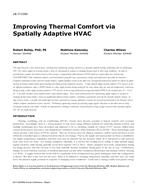Description
This paper presents a new, interior-space, environmental conditioning strategy, referred to as spatially adaptive heating, ventilating, and air conditioning (HVAC), where supply air locations within a room are repositioned in response to changing thermal loads or other room conditions. In order to quantitatively examine the technical merits of this concept, a computational fluid dynamics (CFD) model of a typical office was created using SOLIDWORKS Flow Simulation software and benchmarked using full-scale, experimental, velocity and temperature data from the literature. Computer simulations of flow and heat transfer within a slightly-modified version of this office were subsequently performed to predict the impact of supply location on human comfort under typical heating and cooling mixing ventilation scenarios. A high sidewall supply location yielded a 15% increase in the air diffusion performance index (ADPI) relative to a floor supply location during cooling for the same volume flow rate and inlet temperature. Conversely, during heating, a floor supply location produced a 37% decrease in the average predicted percentage dissatisfied (PPD) in the occupied zone [0 – 1.8 m (0 – 6 ft) above the floor] when compared with a high sidewall supply. These results demonstrated that repositioning supply registers in response to changing thermal loads within a room can significantly improve human comfort–providing a quantitative basis for the spatially adaptive concept. In light of these results, a one-fifth scale model office has been constructed to examine additional scenarios not covered experimentally in the literature and to validate computer simulations of these scenarios. Preliminary engineering concepts for achieving supply register relocation are described and are being investigated using the scale model. Finally, the opportunities, challenges, limitations, and potential for energy savings associated with spatially adaptive HVAC are briefly discussed.
Citation: 2017 Annual Conference, Long Beach, CA, Conference Papers
Product Details
- Published:
- 2017
- Number of Pages:
- 8
- Units of Measure:
- Dual
- File Size:
- 1 file , 920 KB
- Product Code(s):
- D-LB-17-C059




